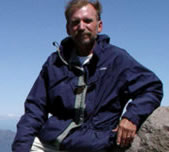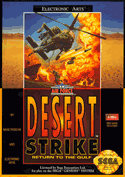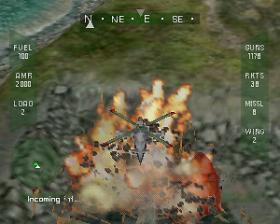In 1992, Electronic Arts set the Genesis on fire with the release of Desert Strike: Return to the Gulf. A unique blend of action and strategy, it gave gamers the chance to take control of an Apache helicopter armed to the teeth to take out the crazed despot General Kilbaba. The incredible gameplay was matched by the need to manage resources and plot the most ideal way to reach each objective. This mostly involved lots of gunfire and explosions. Needless to say, it was a hit.
 The original Desert Strike was ported to many consoles, including the SNES and the Amiga, and was eventually followed by a total of four sequels. The series has sold over four million copies, with the latest installment, Nuclear Strike, appearing on the Playstation, N64, and PC.
The original Desert Strike was ported to many consoles, including the SNES and the Amiga, and was eventually followed by a total of four sequels. The series has sold over four million copies, with the latest installment, Nuclear Strike, appearing on the Playstation, N64, and PC.
Desert Strike was designed and programmed by Mike Posehn, an engineer and independent software creator. Mr. Posehn has been in the industry almost since its inception and is the author of several pioneering products such as Milestone (the first project management program made for PCs) and DeluxeVideoIII (the first “desktop video” product). Eventually, he founded Granite Bay Software and began to develop computer software. He is currently pursuing his interests in digital photography and time-lapse cinematography.
Mr. Posehn was nice enough to take some time out and talk to Sega-16 about the Strike series and his take on the current state of the industry.
Sega-16: How did you get involved in programming and design?
Mike Posehn: While I was an undergraduate student at UC Berkeley in 1966, I also had a student job at Sandia Corporation. I found a self-study book about Fortran and wrote a simple program just for fun and I liked it. In those days programming was done by punching cards and submitting them to the computer center for processing. Sandia was using a CDC 3600 which was a supercomputer at that time.
Although I was a Mechanical Engineering major, I decided to minor in EECS. I finally graduated with a Ph.D. in ME and a M.S. in EECS. After graduating I took a job at Lawrence Livermore Lab and worked in a group that was building mini-computer systems for mechanical testing and data acquisition.
When the first personal computers came out in 1976, I bought one (a Sol-20). I wrote software for my own use, created a few products, and sold them through ads I had placed in Byte Magazine. It was very lucrative, so I quit my job.
Sega-16: Electronic Arts has become huge over the last decade. What was it like to work with them in the early ’90s, before they became such a dominant force in gaming?
Mike Posehn: Actually, I had started a small company in 1980 which was acquired by EA in 1984. At that time there were less than fifty employees at EA and it was a very exciting small company.
I think EA was where the Silicon Valley’s cultural phenomenon known as the Friday Company Meeting was created. It was more like a weekly beer-bust. Trip Hawkins (EA’s founder and president) bought a hundred foam nerf balls as a stress-relief aid and spread them throughout the cubicles. Whenever you were frustrated with a fellow employee or stressed out by a deadline, you could pick up a few nerf balls and start firing away at your co-workers.
They bought my company in order to get our product which they later marketed as Get Organized (a.k.a. GO). It was the first PIM (Personal Information Manager). EA had seen the success of Broderbund’s PrintShop and wanted to expand beyond the video game market. GO was a cool product but was ahead of its time. After lackluster sales, EA decided to “stick to it’s knitting” and dropped the product.
 At that time the Amiga computer was coming out, and EA was making a big push to develop software for it. I left EA as an employee, but wrote something called Deluxe Video for the Amiga. It was the first “Desktop Video” product and was very successful.
At that time the Amiga computer was coming out, and EA was making a big push to develop software for it. I left EA as an employee, but wrote something called Deluxe Video for the Amiga. It was the first “Desktop Video” product and was very successful.
Later on in the ’90s EA was much bigger and higher pressure. I worked twelve hour days, seven days a week for months at a time. Missing the release date was not an option. Decisions became more formalized and were subject to review by other producers. I think the creativity suffered from an aversion to taking risks.
Sega-16: Desert Strike was unlike any other game on the Genesis at the time, giving the player complete freedom to destroy virtually everything in the environment. That’s something we take for granted in gaming today (Grand Theft Auto, Mercenaries). What was the inspiration behind such a breakthrough concept?
Mike Posehn: Trip Hawkins came to me and suggested I write a game. He said he had always liked Choplifter for the Apple II, especially the way you could fly a helicopter and rescue people on the ground. So I took that basic idea and developed the underlying technology for the Strike Games. I wasn’t much of a game player myself and just liked the idea of flying around and blowing things up. I didn’t like being tied to a linear story line.
The other new thing about Desert Strike was the point of view. It was a third-person view with first-person controls. (You looked down at your helicopter, but controlled flight as if you were in the cockpit). That was a tough sell within EA, because most of the experienced producers were convinced it would be too hard for gamers to get the feel of it. I think most players get it within about a minute.
Sega-16: Were there any difficulties in porting the game to the SNES?
Mike Posehn: I didn’t do the SNES or any other ports, so I don’t know. But I am amazed that they squeezed it in. It was tough enough to fit on an 8 megabit Sega cartridge. I think I there were eight unused bytes on the Desert Strike cart. I wrote several custom compression schemes to get it to fit. I always was amused that Sega marketers referred to the size of a cart in megabits (rather than megabytes) to make it sound bigger.
Sega-16: Was there anything you wanted to incorporate into the Genesis Strike games but couldn’t? If so, why not?
Mike Posehn: I was more disappointed by what EA insisted be put into the third game, Urban Strike. They wanted the player to get out of the chopper and move around on the ground. I never did like that part of Urban and would have preferred pumping up the helicopter capabilities.
Sega-16: Which is your favorite Strike game? Why?
Mike Posehn: Jungle Strike is my favorite. With a two megabyte cart we were able to include much richer graphics, and my sprite technology was much better. The story was good and we had some very rich and interesting levels. Unfortunately, EA admittedly dropped the ball on the marketing of Jungle. It could have been a much bigger hit had they put the full A-title resources into it.
Sega-16: Would you one day like to revisit the Strike series?
Mike Posehn: I think about it from time to time, but I don’t enjoy the idea of working on a big team as is the case these days. When I did the Strike games, I wrote every line of code myself.
Sega-16: You’ve been around computer programming since the beginning. Are there any aspects from your days in game programming and design that you feel are missing in today’s industry?
 Mike Posehn: I don’t play today’s games so I don’t really know. I’ve always thought that programming itself is the ultimate game. I wonder if the coders today are as close to the machine as we were in the early days. Today, they rely on code libraries developed by others. How do they know what’s really going on inside the machine?
Mike Posehn: I don’t play today’s games so I don’t really know. I’ve always thought that programming itself is the ultimate game. I wonder if the coders today are as close to the machine as we were in the early days. Today, they rely on code libraries developed by others. How do they know what’s really going on inside the machine?
Sega-16: Do you have any plans to return to game design?
Mike Posehn: No, but I’m having a lot of fun writing photography software. I’m about to release a tool to facilitate time-lapse photography for Canon cameras. Look for an announcement soon at www.gbtimelapse.com.
We would like to thank Mr. Posehn for talking with us and wish him the best in all his future endeavors. We also recommend you visit his website for a first hand look at his great photography work.

Recent Comments